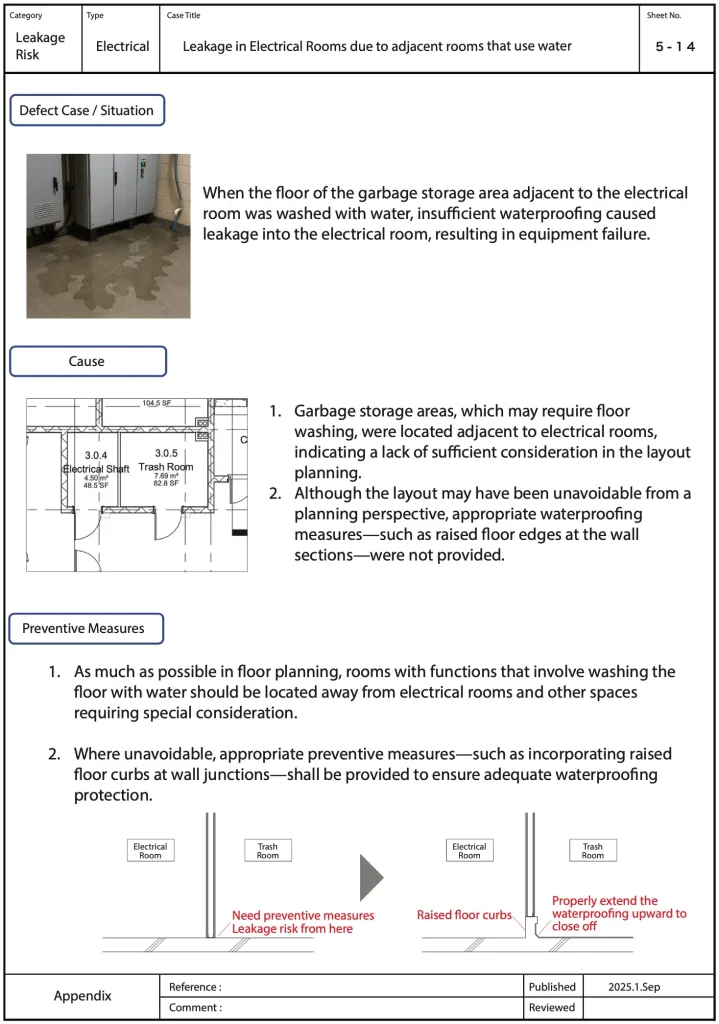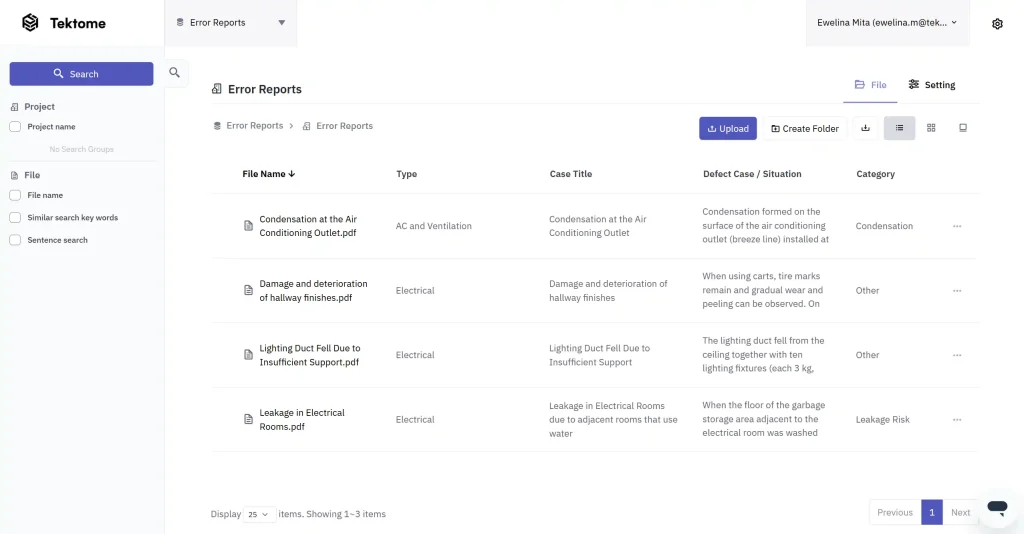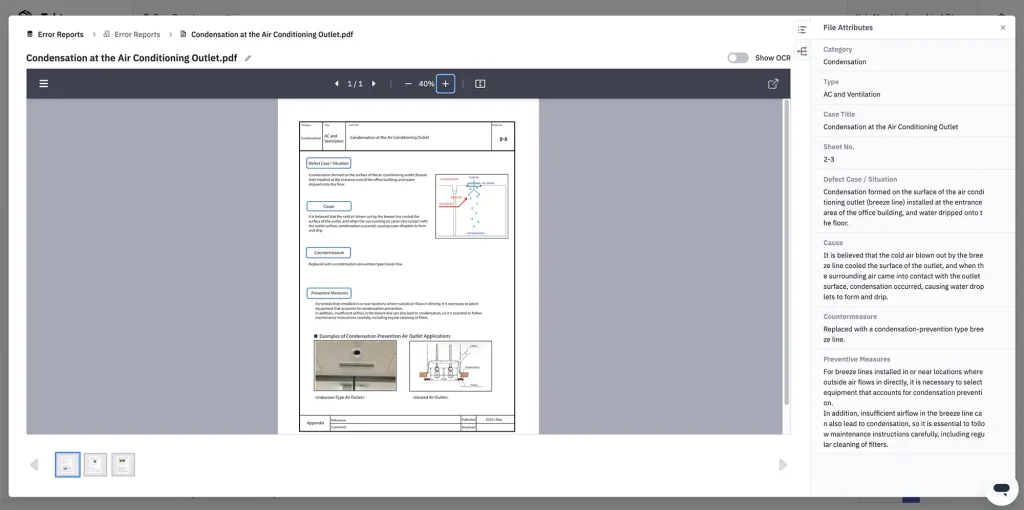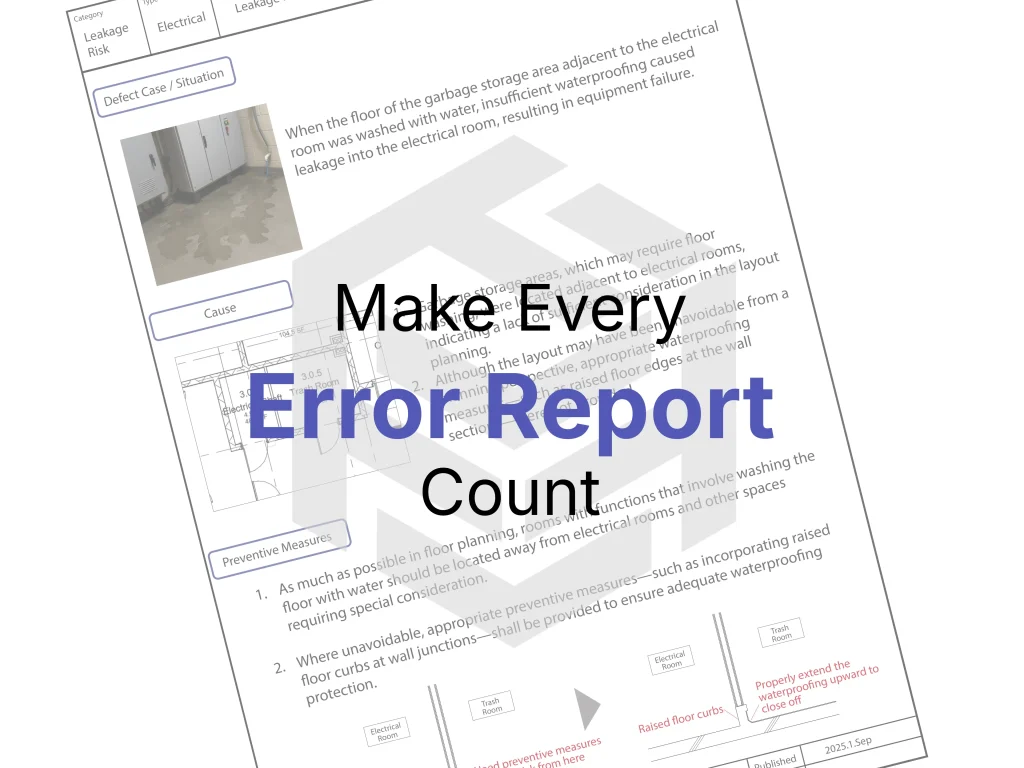In architecture, hard lessons often slip through the cracks. Project teams wrap up and move on, and documented mistakes gather dust in shared folders. This means the same errors can come back to haunt new projects.
Enter Tektome’s KnowledgeBuilder. This AI-driven tool is helping architectural firms transform dry error reports and markups into a living, searchable knowledge base. In this article, we’ll explore how KnowledgeBuilder ensures mistakes from the past don’t repeat by making every error report count.
Use Case – Leakage in Electrical Rooms
Picture this real scenario: An electrical room ended up right next to a garbage wash-down room in a building. One day, facility staff hosed down the garbage room floor and water seeped through into the adjacent electrical room. The insufficient waterproofing at the partition meant water infiltrated the electrical space, shorting equipment and causing failure.
In the ensuing investigation, architects quickly identified the design defect. The layout itself was a root cause: a wet garbage area sharing a wall with a sensitive electrical room showed a lack of consideration in planning. And even if that adjacency was unavoidable, the architects admitted they hadn’t provided proper safeguards. For example, there was no raised barrier or “curb” at the base of the wall to block water. The original design basically gave water an open door to flow under.
The fix was straightforward: after repairing the damage, the team added a small base wall (raised floor curb) along the shared wall of the electrical room to create a waterproof barrier. They also extended the floor waterproofing membrane up that curb to fully seal the joint. In future projects, the firm vowed to plan more carefully – if a water-use room (like a trash wash area) must be next to an electrical or server room, they will either reposition it or build in proper curbs and upturned waterproofing at the junction. These recommendations were all captured in an internal error report, complete with an annotated drawing. The report’s diagram highlighted the leakage path and showed the new raised floor curb detail to prevent it.

Water leakage error report
However, as is often the case, such error reports typically get filed away or emailed around and then forgotten. Even with firm-wide circulation, there’s no guarantee everyone will remember this specific lesson next time they’re laying out a similar floor plan. This is where KnowledgeBuilder comes in. Instead of living in someone’s inbox, that “leakage in electrical room” case becomes searchable knowledge. An architect starting a new project can simply query, “electrical room adjacent to wet room”, and instantly pull up that past case – complete with the design recommendations and even the drawing snippet showing the base curb solution.

Rapid Search with Context
Having a well-indexed repository of past reports is great, but the real game-changer is how you retrieve the information. KnowledgeBuilder provides a Google-like search experience tailored to design and construction data. You don’t need to remember exact file names or report titles. Simply ask in natural language, and the system will do the rest. The AI is smart enough to interpret your query’s intent and find relevant info without you specifying exact keywords.
For instance, you might search “water leak in server room” even if the report was titled “electrical room leakage” – KnowledgeBuilder will still surface that case, because it understands “server room” and “electrical room” contextually and knows the report is about a leak issue. This semantic search ensures that differences in terminology (garbage room vs. trash room, etc.) won’t stop you from finding what you need.
Build Better Habits
Integrating KnowledgeBuilder into an architectural practice isn’t just a tech upgrade – it’s a cultural shift toward continuous improvement. When lessons from past mistakes are only a quick search away, teams naturally start checking the knowledge base during design decisions.
Over time, this operationalises learning from past errors: consulting previous cases becomes a habit, and preventing repeat mistakes becomes part of the firm’s DNA. Firms can even bake these learnings into their standards. For example, after the electrical room leak, the firm might update its internal design checklist to always verify “water-use rooms adjacent to critical rooms have waterproofing/curb” as a line item. KnowledgeBuilder makes it easy to gather such insights because it shows patterns across projects. Teams iterate on their designs with the collective memory of the firm guiding them. Instead of each project team learning the hard way on their own, the firm as a whole gets smarter project by project.

Error report with automatically extracted attributes in KnowledgeBuilder
The result is not just avoiding errors, but designing better from the start. Quality improves when known pitfalls are actively avoided and proven solutions reused. Morale gets a boost too – architects can feel confident they aren’t missing something obvious from past experience, and younger staff ramp up faster by tapping into the firm’s knowledge repository.
Summary
Every project hiccup or mistake you document is untapped knowledge that could save your team time and headaches down the road – if only it’s made accessible. Tektome’s KnowledgeBuilder ensures those lessons are not only preserved but readily discoverable when it counts.
By turning error reports and other project data into a smart knowledge base, teams can reuse proven solutions and avoid repeated mistakes, moving forward with confidence. In our example, a single leakage incident led to a design tweak that, thanks to KnowledgeBuilder, can be propagated to all future projects before any damage is done. That’s the power of making every error report count: you don’t just fix the last project’s issues – you improve all your future ones.
Ready to stop learning the hard way? Make your firm’s collective experience work for you. Explore Tektome KnowledgeBuilder and see how it can transform your error reports and design documents into actionable insights.
Visit tektome.com/knowledgebuilder to learn more and kick-start a smarter way to capture and use your team’s knowledge. Your next project (and your future self) will thank you.

